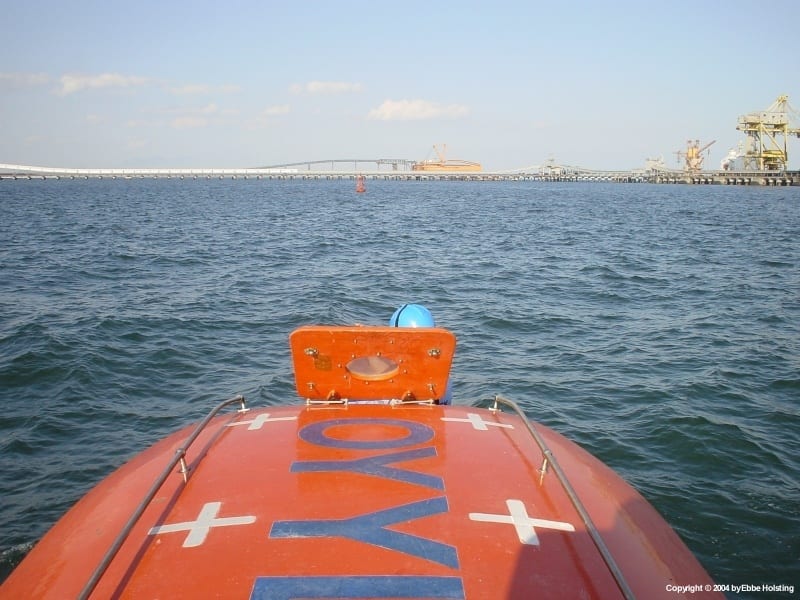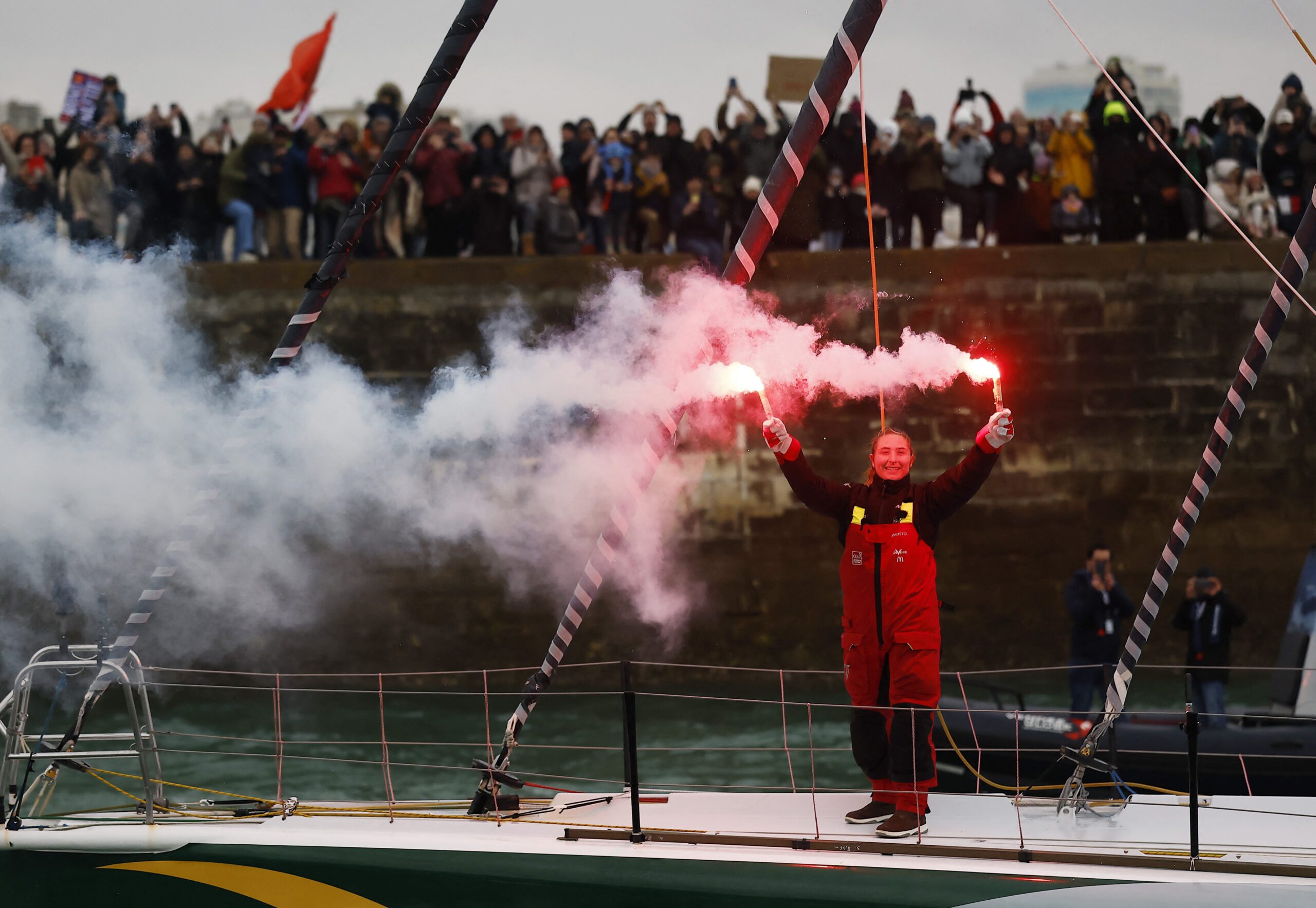
Over the past two days gCaptain has fielded questions from the Wall Street Journal, Associated Press, Good Morning America and a number of other well known organizations, each trying to get a better idea of situation aboard the Maersk Alabama.
Last night it was reported that the vessel’s master, Captain Phillips, volunteered to be taken hostage and help the pirates escape via the ship’s lifeboat. Today, questions from the press centered around the lifeboat. Here is a short FAQ to help you understand the conditions aboard the boat that currently holds the pirates and ship’s master:
What Kind Of Lifeboats Does The Maersk Alabama Carry?
We don’t know the specifics but have been told by sources at Mass Maritime Academy that the vessel carries the same lifeboats as the school’s training ship, The Golden Bear Kennedy. This would make them totally enclosed boats, similar to the one pictured above.
How much food and water is aboard the lifeboat?
Regulations state that the boat must have a food rations totaling not less than 10,000 kJ for each person the lifeboat is permitted to accommodate; these rations shall be kept in airtight packaging and be stowed in a watertight container.
The boat is also required to carry watertight receptacles containing a total of 3 liters of fresh water for each person the lifeboat is permitted to accommodate.
28 foot boats typically have a capacity to carry over 50 individuals. In other words, the captain and four pirates “could” survive for a few weeks.
What type of food does it carry?
 The purpose of emergency food rations is to deliver the maximum number of calories in the smallest, most durable packaging. This means they taste similar to compacted cardboard with a biscuit flavor. Here is a photo of the packaging (details HERE).
The purpose of emergency food rations is to deliver the maximum number of calories in the smallest, most durable packaging. This means they taste similar to compacted cardboard with a biscuit flavor. Here is a photo of the packaging (details HERE).
Why did the boat run out of gas?
The boat is required to have sufficient fuel to run the fully loaded lifeboat at 6 knots for a period of not less than 24 hours which is 144 nautical miles ( 165.7 statute miles) but it only traveled a few. Why?
There are two likely explanations for this. First safety inspections are carried out by the 3rd mate who is the most junior (i.e. inexperienced) officer. It is possible that he missed a problem with the lifeboat engines or fuel delivery system.
A less likely answer is that the captain sabotaged the engine. It is necessary to connect the battery switch which is often located in the engine compartment, giving Captain Phillips an excuse to open the hatch. Once in the hatch you could crimp the fuel line or block the air intake system, being a diesel engine, restricting fuel or air are the only two ways to safely stop and engine once started.
What other equipment does the boat carry?
Here’s a list:
1 sufficient buoyant oars to make headway in calm seas.
.2 two boat-hooks;
.3 a buoyant bailer and two buckets;
.4 a survival manual ;
.5 an operational compass which is luminous or provided with suitable means of illumination permanently fitted at the steering position.
.6 a sea-anchor of adequate size fitted with a shock-resistant hawser .
.7 two efficient painters (i.e. ropes) of a length equal to not less than twice the distance from the stowage position of the lifeboat to the waterline in the lightest seagoing condition or 15 m, whichever is the greater. placed at the forward end of the lifeboat and the other shall be firmly secured at or near the bow of the lifeboat ready for use;
.8 two hatchets, one at each end of the lifeboat; (these are used to cut the painters)
.9 watertight receptacles containing a total of 3 l of fresh water for each person the lifeboat is permitted to accommodate,
.10 a rustproof dipper with lanyard;
.11 a rustproof graduated drinking vessel;
.12 a food ration totalling not less than 10,000 kJ for each person the lifeboat is permitted to accommodate; these rations shall be kept in airtight packaging and be stowed in a watertight container;
.13 parachute flares complying with the requirements of section 3.1;
.14 hand flares
.15 two buoyant smoke signals complying with the requirements of section 3.3;
.16 one waterproof electric torch suitable for Morse signalling together with one spare set of batteries and one spare bulb in a waterproof container;
.17 one daylight signalling mirror with instructions for its use for signalling to ships and aircraft;
.18 one copy of the life-saving signals prescribed by regulation V/16 on a waterproof card or in a waterproof container;
.19 one whistle or equivalent sound signal;
.20 a first-aid outfit in a waterproof case capable of being closed tightly after use;
.21 anti-seasickness medicine sufficient for at least 48 h and one seasickness bag for each person;
.22 a jack-knife, to be kept attached to the boat by a lanyard;
.23 three tin-openers;
.24 two buoyant rescue quoits, attached to not less than 30 m of buoyant line;
.25 if the lifeboat is not automatically self-bailing, a manual pump suitable for effective hailing;
.26 one set of fishing tackle;
.27 sufficient tools for minor adjustments to the engine and its accessories;
.28 portable fire-extinguishing equipment of an approved type suitable for extinguishing oil fires;
.29 a searchlight with a horizontal and vertical sector of at least 6° and a measured luminous intensity of 2,500 cd which can work continuously for not less than 3 h;
.30 an efficient radar reflector, unless a survival craft radar transponder is stowed in the lifeboat;
.31 thermal protective aids complying with the requirements of section 2.5 sufficient for 10% of the number of persons the lifeboat is permitted to accommodate or two, whichever is the greater
Can the navy “track” the lifeboat?
The lifeboat is equipped with various passive tracking features including high visibility (SOLAS) reflective tape, a radar reflector and “International Orange” paint scheme. It also has a VHF radio and a Search And Rescue Transponder (SART – which can be tracked by the ship’s radar), both of which need to be manually activated by the captain. It is also possible that the captain took an EPIRB with him as lifeboats rarley carry individual EPIRB units (the better companies store PLB’s in each lifeboat).
Lifeboats do not carry AIS vessel tracking transceivers or any other type of “Auto-On” tracking devices.
Any More Questions?
If you have any more questions about lifeboats please submit a question in the comments section and we will be sure to answer them.
Links
Norsafe – Leading MFG of Lifeboats
Interview With Mass Maritime on Maersk Alabama’s Life boats
Photos
 A Maersk Lifeboat Underway. Photo By Menkent
A Maersk Lifeboat Underway. Photo By Menkent
 Enclosed Lifeboat on Davit.
Enclosed Lifeboat on Davit.
Lifeboat On Stored Davit
 Lifebaot Floating In The Water.
Lifebaot Floating In The Water.
Inside A Lifeboat

 Photo By Seth White.
Photo By Seth White.

 Join The Club
Join The Club




 The purpose of emergency food rations is to deliver the maximum number of calories in the smallest, most durable packaging. This means they taste similar to compacted cardboard with a biscuit flavor. Here is a photo of the packaging (details
The purpose of emergency food rations is to deliver the maximum number of calories in the smallest, most durable packaging. This means they taste similar to compacted cardboard with a biscuit flavor. Here is a photo of the packaging (details 
 Enclosed Lifeboat on Davit.
Enclosed Lifeboat on Davit. Lifebaot Floating In The Water.
Lifebaot Floating In The Water.
 Photo By
Photo By 




